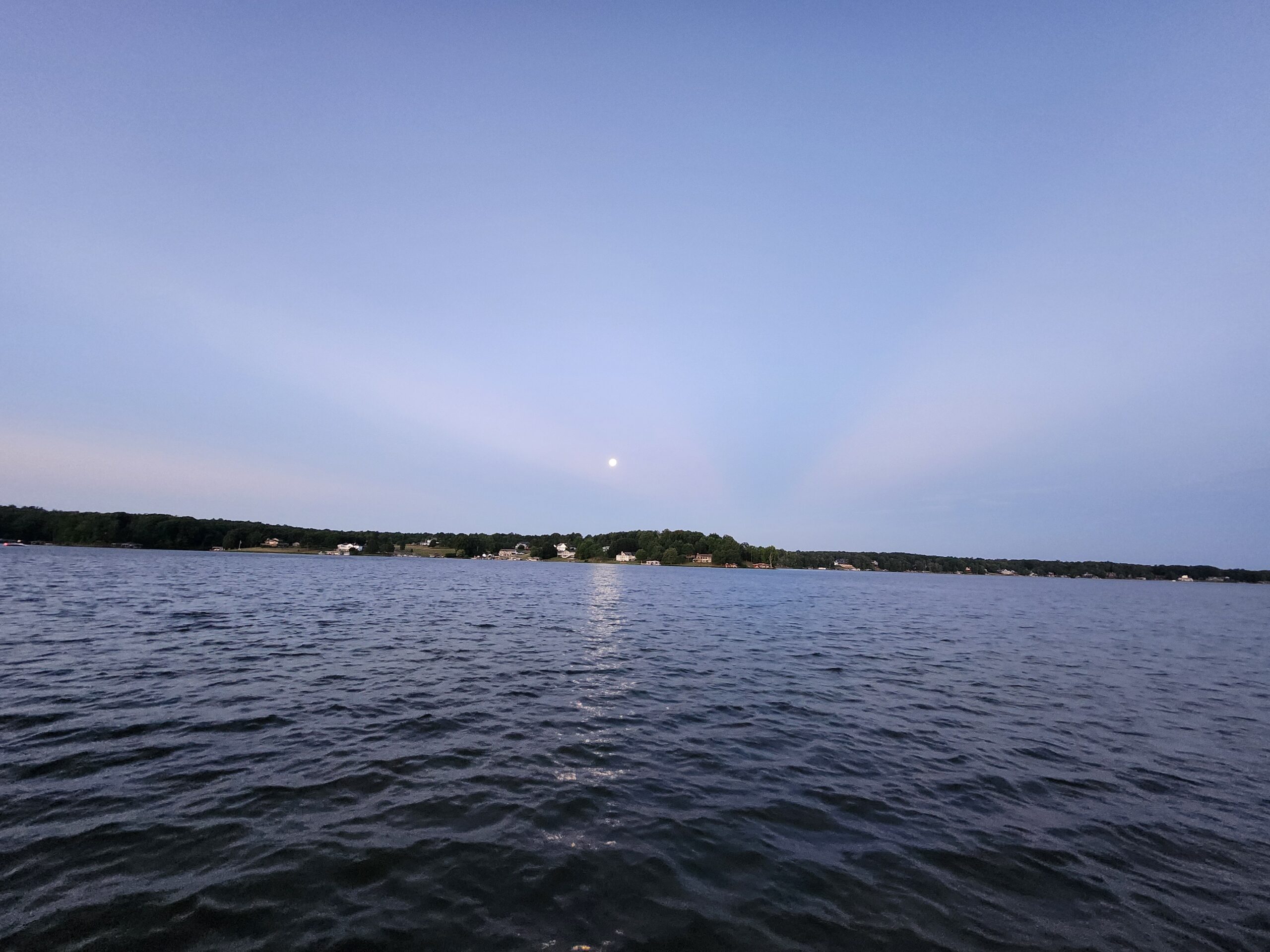
Almost every day, as we look into the atmosphere, we can see some beautiful—and sometimes unusual—optical sights. These occur due to sunlight interacting with particles in the atmosphere.
Light from the sun is made up of a spectrum of colors that we normally perceive as plain white light. But as this light passes through water, ice, smog, or smoke, the particles in the atmosphere reflect and refract the light, sometimes revealing the individual colors of the spectrum or creating interesting patterns and shapes. The spectrum of light is made up of Red, Orange, Yellow, Green, Blue, Indigo, and Violet. I remember trying to memorize these in high school physics using the acronym ROY G. BIV.
A rainbow clearly shows all the colors of the spectrum by bending the light, similar to how a prism works.
As the light passes through raindrops, the curved surfaces of the drops bend the light so that it breaks into the seven individual colors. This bending, or refraction, occurs due to the molecular makeup of water. You can prove this by placing a stick into a large bucket of water—the stick will appear to bend sharply where it enters the water. You can also make a rainbow at home by letting light pass through a glass of water and strike a wall; you should see a rainbow form on the wall. Double rainbows can occur as well. When they do, the second rainbow is usually much dimmer, and the colors are reversed. This second rainbow is called a supernumerary rainbow.
A sun dog is a bright spot that forms to the immediate right and left of the sun when thin layers of hexagonal ice crystals fall through the atmosphere with their longest axis in a vertical position. These ice crystals make up cirrus clouds, usually found 25,000 to 40,000 feet up. The bright spots appear exactly 22 degrees to the right and left of the sun and usually form when the sun is near the horizon. Sometimes, you’ll also see a 22-degree halo associated with sun dogs.
Crepuscular rays are bands of sunlight shining through breaks in the clouds. These usually occur during sunset or sunrise, with towering cumulus clouds between you and the sun. They are sometimes called “Jacob’s Ladder.”
Diamond dust consists of very small ice crystals falling slowly through the atmosphere. They sparkle as they fall, reflecting light to resemble diamonds in the sky. This phenomenon usually occurs in very cold climates with temperatures below zero.
Why is the sky blue? This question has been asked of parents for centuries and is actually simple to explain. Air molecules scatter the colors of the spectrum differently due to their varying wavelengths. This is called Rayleigh scattering. The blue portion of the spectrum is the dominant color scattered in Earth’s atmosphere, which is why we mostly see a blue sky. When there’s a lot of haze in the atmosphere—typical of a Northern Virginia summer afternoon—the scattering caused by the haze makes the sky appear milky white instead of blue.
Halos form around the sun or moon and are caused by a thin veil of ice crystals that refract light. If you look closely, you’ll see red on the inner edge and blue on the outer edge. Most halos form at a 22-degree angle from the sun or moon.
A mirage is the refraction of sunlight that causes the image of an object to appear in a different location than its actual one. We often see this on hot summer afternoons while driving down the road. In the distance, you might see a bright layer that looks like water. The very hot air near the surface is refracting the sun’s rays back into your field of view, and your brain interprets this as a layer of water.
Sun pillars are vertical streaks of light that extend above or below the sun. Most sun pillars occur just before sunrise or just after sunset, when the sun is below the horizon. They form from the reflection of light off ice crystals. You can also see light pillars during very cold nights above streetlights when ice crystals are present in the air.
The next time you look up at the sky and see one of these phenomena, you’ll be able to enjoy the view even more—now that you know the reason it’s there.

I grew up an Air Force Brat. Traveled the country and lived in Georgia, Maine, New York, Hawaii and Oklahoma.
I fell in love with the weather in Oklahoma. My father was transferred to Tinker AFB in 1973. While in Temporary housing (a mobile home, which is the standard in Oklahoma) I experienced my first severe thunderstorm with strong winds and hail the size of baseballs. The next day I was in the base library looking up books on weather. The rest is history.
I graduated from the University of Oklahoma in 1983 with a Bachelor’s Degree in Meteorology. The first two years we took Calculus, Differential equations, Physics, Chemistry and Computer science classes with the Engineering Students. It was a grind. My degree is actually from the College of Engineering. The last 2-3 year’s focus was on Meteorology including Observational networks (Satellite, Radar, Surface), Physics, Thermodynamics, Dynamics, Synoptic, Winter Weather, Severe Weather and Climatology.
My first job out of college was with a small forecasting company in Oklahoma City. I was immediately put on TV (OETA) and Radio (WKY) as their broadcast Meteorologist. After two years in broadcasting, I decided to pursue the National Weather Service route and got a position in Toledo, OH as an intern. After a couple of years, I was promoted to a forecaster position at the Cleveland Forecast office. I quickly moved into the Weather Preparedness position and was responsible for all the preparedness activities in the state of Ohio.
In 1992 I decided to pursue other forecast opportunities and moved to the Meteorological Operations Division of the National Meteorological Center in Washington, DC. This group is now called WPC (Weather Prediction Center). There I fine-tuned my forecasting of Synoptic Weather with my focus on Heavy Convective Rainfall and Winter Storms, under the supervision of Dr. Louis Uccellini. He has written several books on East Coast Winter storms. I was promoted to a Senior Branch Forecast position during my tenure at MOD. Part of my job was to teach weather classes at COMET (Cooperative Program for Operational Meteorology, Education, and Training).
In 2012 I was given the opportunity to start up a new weather support group with the FAA (Federal Aviation Administration) in Warrenton, VA at the ATCSSC (Air Traffic Control System Command Center). The ATCSCC is where the FAA identifies solutions to air traffic inefficiencies in the NAS (National Air Space) for the CONUS (Continental United State). Weather impacts are the biggest impact on Aviation with yearly losses over 20 billion dollars. My job was to help lower these inefficiencies/costs by providing weather impact briefings and forecasts in order to keep the air planes moving as safely and efficiently as possible.
I retired in 2022 and now am running Lake Anna Weather, LLC.
Subscribe for Updates
Sponsors
latest articles
[Sponsored] Raised to Life: Tent Revival Returns to Its Roots at Lake Anna
![Featured image for “[Sponsored] Raised to Life: Tent Revival Returns to Its Roots at Lake Anna”](https://lakeanna.online/wp-content/uploads/2025/07/Blog-pic.png)
Plan Ahead for a Safe and Sober Holiday Weekend on the Water [Photo Gallery]
![Featured image for “Plan Ahead for a Safe and Sober Holiday Weekend on the Water [Photo Gallery]”](https://lakeanna.online/wp-content/uploads/2025/06/DFW-RIde-Along-8104.jpg)
Fully Community-Funded Rescue Boat Brings Life-Saving Power to the Water

[Sponsored] Holmes on Homes: Business Built on Trust, Grit and Quality
![Featured image for “[Sponsored] Holmes on Homes: Business Built on Trust, Grit and Quality”](https://lakeanna.online/wp-content/uploads/2025/06/FinalHolmes-1.jpg)
Jet Boat Community Celebrates Service and Safety at 2025 Lake Anna Invasion

Best of Lake Anna Corrections & Announcements

Almost every day, as we look into the atmosphere, we can see some beautiful—and sometimes unusual—optical sights. These occur due to sunlight interacting with particles in the atmosphere.
Light from the sun is made up of a spectrum of colors that we normally perceive as plain white light. But as this light passes through water, ice, smog, or smoke, the particles in the atmosphere reflect and refract the light, sometimes revealing the individual colors of the spectrum or creating interesting patterns and shapes. The spectrum of light is made up of Red, Orange, Yellow, Green, Blue, Indigo, and Violet. I remember trying to memorize these in high school physics using the acronym ROY G. BIV.
A rainbow clearly shows all the colors of the spectrum by bending the light, similar to how a prism works.
As the light passes through raindrops, the curved surfaces of the drops bend the light so that it breaks into the seven individual colors. This bending, or refraction, occurs due to the molecular makeup of water. You can prove this by placing a stick into a large bucket of water—the stick will appear to bend sharply where it enters the water. You can also make a rainbow at home by letting light pass through a glass of water and strike a wall; you should see a rainbow form on the wall. Double rainbows can occur as well. When they do, the second rainbow is usually much dimmer, and the colors are reversed. This second rainbow is called a supernumerary rainbow.
A sun dog is a bright spot that forms to the immediate right and left of the sun when thin layers of hexagonal ice crystals fall through the atmosphere with their longest axis in a vertical position. These ice crystals make up cirrus clouds, usually found 25,000 to 40,000 feet up. The bright spots appear exactly 22 degrees to the right and left of the sun and usually form when the sun is near the horizon. Sometimes, you’ll also see a 22-degree halo associated with sun dogs.
Crepuscular rays are bands of sunlight shining through breaks in the clouds. These usually occur during sunset or sunrise, with towering cumulus clouds between you and the sun. They are sometimes called “Jacob’s Ladder.”
Diamond dust consists of very small ice crystals falling slowly through the atmosphere. They sparkle as they fall, reflecting light to resemble diamonds in the sky. This phenomenon usually occurs in very cold climates with temperatures below zero.
Why is the sky blue? This question has been asked of parents for centuries and is actually simple to explain. Air molecules scatter the colors of the spectrum differently due to their varying wavelengths. This is called Rayleigh scattering. The blue portion of the spectrum is the dominant color scattered in Earth’s atmosphere, which is why we mostly see a blue sky. When there’s a lot of haze in the atmosphere—typical of a Northern Virginia summer afternoon—the scattering caused by the haze makes the sky appear milky white instead of blue.
Halos form around the sun or moon and are caused by a thin veil of ice crystals that refract light. If you look closely, you’ll see red on the inner edge and blue on the outer edge. Most halos form at a 22-degree angle from the sun or moon.
A mirage is the refraction of sunlight that causes the image of an object to appear in a different location than its actual one. We often see this on hot summer afternoons while driving down the road. In the distance, you might see a bright layer that looks like water. The very hot air near the surface is refracting the sun’s rays back into your field of view, and your brain interprets this as a layer of water.
Sun pillars are vertical streaks of light that extend above or below the sun. Most sun pillars occur just before sunrise or just after sunset, when the sun is below the horizon. They form from the reflection of light off ice crystals. You can also see light pillars during very cold nights above streetlights when ice crystals are present in the air.
The next time you look up at the sky and see one of these phenomena, you’ll be able to enjoy the view even more—now that you know the reason it’s there.

I grew up an Air Force Brat. Traveled the country and lived in Georgia, Maine, New York, Hawaii and Oklahoma.
I fell in love with the weather in Oklahoma. My father was transferred to Tinker AFB in 1973. While in Temporary housing (a mobile home, which is the standard in Oklahoma) I experienced my first severe thunderstorm with strong winds and hail the size of baseballs. The next day I was in the base library looking up books on weather. The rest is history.
I graduated from the University of Oklahoma in 1983 with a Bachelor’s Degree in Meteorology. The first two years we took Calculus, Differential equations, Physics, Chemistry and Computer science classes with the Engineering Students. It was a grind. My degree is actually from the College of Engineering. The last 2-3 year’s focus was on Meteorology including Observational networks (Satellite, Radar, Surface), Physics, Thermodynamics, Dynamics, Synoptic, Winter Weather, Severe Weather and Climatology.
My first job out of college was with a small forecasting company in Oklahoma City. I was immediately put on TV (OETA) and Radio (WKY) as their broadcast Meteorologist. After two years in broadcasting, I decided to pursue the National Weather Service route and got a position in Toledo, OH as an intern. After a couple of years, I was promoted to a forecaster position at the Cleveland Forecast office. I quickly moved into the Weather Preparedness position and was responsible for all the preparedness activities in the state of Ohio.
In 1992 I decided to pursue other forecast opportunities and moved to the Meteorological Operations Division of the National Meteorological Center in Washington, DC. This group is now called WPC (Weather Prediction Center). There I fine-tuned my forecasting of Synoptic Weather with my focus on Heavy Convective Rainfall and Winter Storms, under the supervision of Dr. Louis Uccellini. He has written several books on East Coast Winter storms. I was promoted to a Senior Branch Forecast position during my tenure at MOD. Part of my job was to teach weather classes at COMET (Cooperative Program for Operational Meteorology, Education, and Training).
In 2012 I was given the opportunity to start up a new weather support group with the FAA (Federal Aviation Administration) in Warrenton, VA at the ATCSSC (Air Traffic Control System Command Center). The ATCSCC is where the FAA identifies solutions to air traffic inefficiencies in the NAS (National Air Space) for the CONUS (Continental United State). Weather impacts are the biggest impact on Aviation with yearly losses over 20 billion dollars. My job was to help lower these inefficiencies/costs by providing weather impact briefings and forecasts in order to keep the air planes moving as safely and efficiently as possible.
I retired in 2022 and now am running Lake Anna Weather, LLC.
Subscribe for Updates
Sponsors
latest articles
[Sponsored] Raised to Life: Tent Revival Returns to Its Roots at Lake Anna
![Featured image for “[Sponsored] Raised to Life: Tent Revival Returns to Its Roots at Lake Anna”](https://lakeanna.online/wp-content/uploads/2025/07/Blog-pic.png)
Plan Ahead for a Safe and Sober Holiday Weekend on the Water [Photo Gallery]
![Featured image for “Plan Ahead for a Safe and Sober Holiday Weekend on the Water [Photo Gallery]”](https://lakeanna.online/wp-content/uploads/2025/06/DFW-RIde-Along-8104.jpg)
Fully Community-Funded Rescue Boat Brings Life-Saving Power to the Water

[Sponsored] Holmes on Homes: Business Built on Trust, Grit and Quality
![Featured image for “[Sponsored] Holmes on Homes: Business Built on Trust, Grit and Quality”](https://lakeanna.online/wp-content/uploads/2025/06/FinalHolmes-1.jpg)
Jet Boat Community Celebrates Service and Safety at 2025 Lake Anna Invasion

Best of Lake Anna Corrections & Announcements


Belmont Ruritan Clubs Award $26,000 in Scholarships to Local Seniors
Article By Jen Bailey

Exclusive Golf Excursions for Cutalong Members
Article By Jen Bailey






